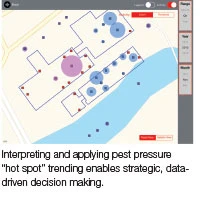
Over the last five to ten years, the Centers for Disease Control and Prevention (CDC) reported food safety-related statistics have remained alarmingly consistent in the U.S. There have been more than 128,000 hospitalizations and 3,000 deaths annually and as many as 50 million cases of “food poisoning”—clearly unacceptable numbers. Driven by a food safety-conscious culture eager to realize a reduction in foodborne illnesses and deaths, the Food Safety Modernization Act (FSMA) represented the most sweeping overhaul of the food safety system since 1938.
In 2015, the true impact of FSMA legislation will become evident as final verbiage adjustments are made and FDA publishes the final rules. For pest management, FSMA emphasizes strategic, risk-based assessment of Integrated Pest Management (IPM) programs, supported by thorough, accurate documentation and consistent corrective-action implementation and management.
Further, FSMA places the responsibility for food safety and adhering to a FSMA-compliant IPM program squarely on the shoulders of the food facility. With new authority outlined in FSMA, including the ability to implement a mandatory recall or invoke hefty fines for violations, the FDA also has more authority to dictate pest management standards in food manufacturing.
Collaboration.
Collaboration between the food facility and pest management service provider is the cornerstone of delivering an effective IPM program that meets FSMA requirements. In fact, without true partnership and a mutual commitment to food safety, it is almost a certainty that pest management efforts will fail.
Sharing a focus on pest prevention by communicating and addressing structural and sanitation conditions and promptly correcting employee pest-conducive behavior patterns are critical steps in proving that an IPM program is working as intended. And, the only way to do that is to document, document, document. Then resolve, resolve, resolve. The old (and admittedly over-used) adage of “the devil is in the details” has never applied more.
Leveraging Technology.
 Thankfully, with advances in technology, documentation and communication of an IPM program have become easier using a tablet-based device or smart phone. For instance, with a direct link to service data, corrective action in response to pest activity breaching a predetermined threshold can be automatically triggered, setting a plan in motion and electronically notifying all stakeholders of the change in status.
Thankfully, with advances in technology, documentation and communication of an IPM program have become easier using a tablet-based device or smart phone. For instance, with a direct link to service data, corrective action in response to pest activity breaching a predetermined threshold can be automatically triggered, setting a plan in motion and electronically notifying all stakeholders of the change in status.
More importantly, tools like electronic logbooks enable more advanced, visually driven trending. In addition to enabling pest-activity trending (catches, sightings, and evidence) and condition monitoring, sophisticated mapping tools can be used to identify and track pest pressure “hot spots,” presented in a user-friendly app interface. The best mapping tools available now offer a geo-spatial view that overlays satellite-driven imagery of the surrounding geography for a full picture of all environmental factors influencing the pest management program.
Finally, one of the most beneficial implications of this technology extends beyond the actual device and rests on the shoulders of the professional pest management service provider and the facility manager. Strategic analysis and application of these trends, from mapping to reports to an IPM program, can result in data-driven modifications that further improve the program’s results overall. For example, an analysis of facility trending might suggest an increase in inspection; changes in the quantity or placement of devices; adjustments to service frequency; and/or recommendations for special services to address needs of the site.
Just as the partnership between a pest management provider and facility management is essential to the success of an IPM program, so too is the right combination of the implementation and usage of technology and the analysis and application of the data it provides.
The documentation and communication of the “devilish” details build the foundation and, ultimately, impact the success of a pest management program in a food manufacturing facility.
Latest from Quality Assurance & Food Safety
- Chef Robotics Introduces Pat-Down Capability for Meal Presentation and Sealing
- USDA Launches Regenerative Pilot Program
- Indoor Ag-Con Adds Food Safety Track to Conference Lineup
- IDFA Recognizes Federal Officials for Support of U.S. Dairy Industry
- Tetra Pak Acquires Bioreactors.net
- Fresh Del Monte Receives Rabobank Leadership Award
- São Paulo Earns Guinness World Record for Largest Municipal Food Security Program
- KPM Analytics Releases Ready-to-Use NIR Calibration Packages





